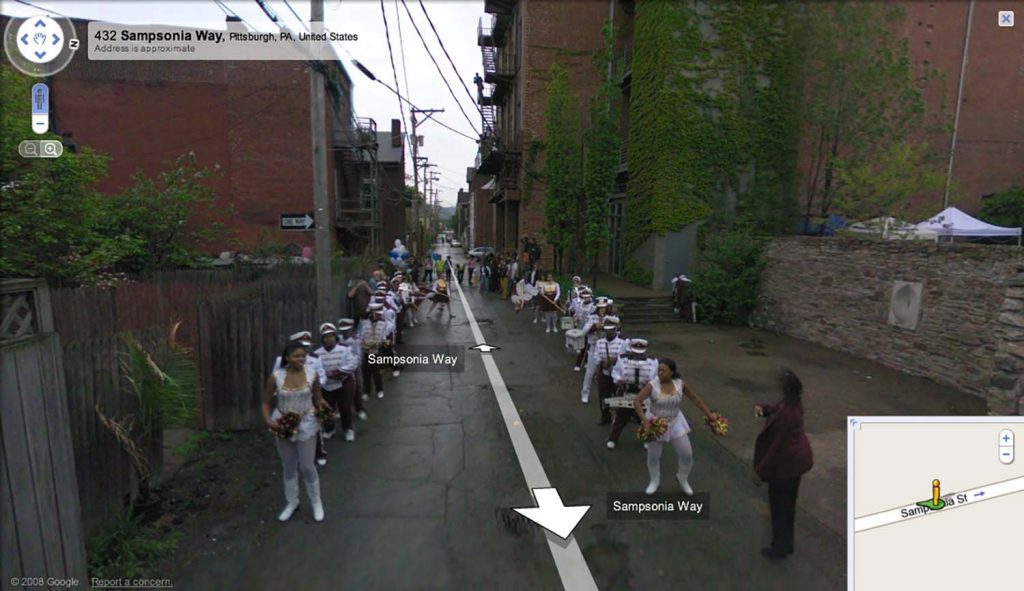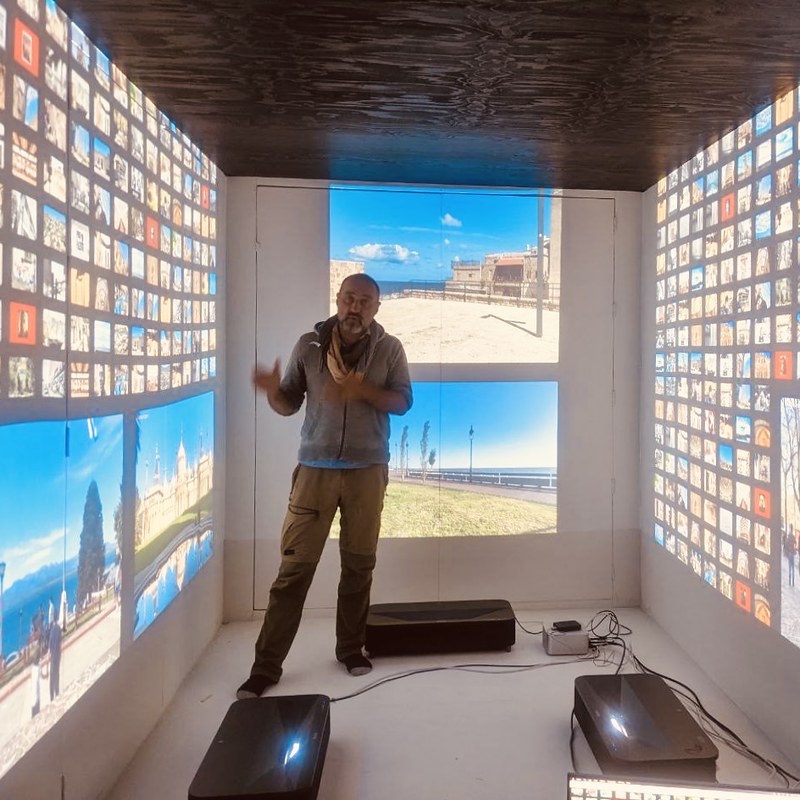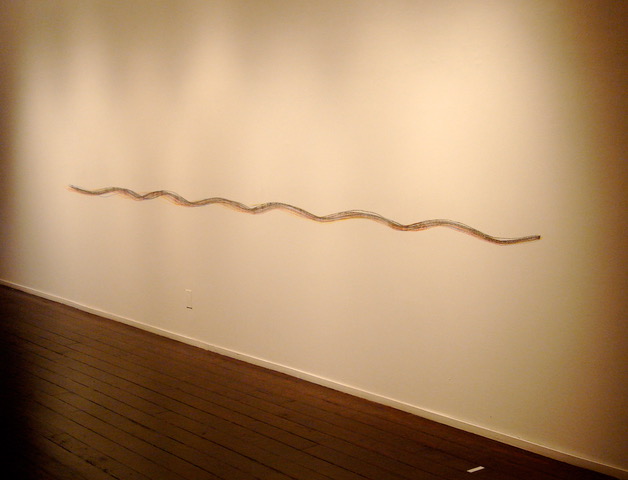This zine I created for a walking workshop in Hudson, WI earlier this fall is now available on my site! Walking Workbook: All the Affordances
I also have a few others in my shop:
by Ellen Mueller on October 18, 2023, no comments
This zine I created for a walking workshop in Hudson, WI earlier this fall is now available on my site! Walking Workbook: All the Affordances
I also have a few others in my shop:
by Ellen Mueller on October 16, 2023, no comments

Ben Kinsley & Robin Hewlett, Street With a View, 2008, screen capture from Google Street View; Courtesy: Ben Kinsley & Robin Hewlett, © Google, Inc.
As part of the release of the hardcover release of my book, Walking as Artistic Practice (softcover comes out in April!), I’m going to be publishing some brief interviews with the various artists, authors, researchers, creatives, collectives, and platforms whose art practice, written material, or other works I cite and mention.
My ninth interview in this series is with Ben Kinsley whose projects have ranged from choreographing a neighborhood intervention into Google Street View, directing surprise theatrical performances inside the homes of strangers, organizing a paranormal concert series, staging a royal protest, collecting put-down jokes from around the world, and planting a buried treasure in the streets of Mexico City (yet to be found). Kinsley is an Assistant Professor and Co-Director of Visual Art in the Department of Visual & Performing Arts at the University of Colorado, Colorado Springs. He is Co-Founder of The Yard and former President of the Pikes Peak Mycological Society.
EM: First, thank you for chatting with me about your collaborative work, Street With a View (2008), created with Robin Hewlett. This piece is mentioned multiple times in Walking as Artistic Practice. How would you describe this work for people who might not be familiar with it?
BK: Street With a View was a community intervention into Google Street View maps. Robin and I were living in Pittsburgh in 2007 when Google opened up a headquarters there. Street View was a new technology, and they soon began documenting the streets. It caused quite a stir and raised questions of privacy. There were lawsuits filed on behalf of individuals whose houses were captured on private drives. We asked ourselves “if we knew the car was coming down our street, how might we respond?” In the end, we organized a neighborhood to respond to this question. Various scenes were staged, some ordinary and some fantastical, to be captured by the Street View car and embedded within Google Maps. At first, we had envisioned this being a guerilla intervention, but this was not really feasible. So we proposed the idea to Google and, several months later, ended up working directly with the Street View team. We staged the scene along Sampsonia Way, a small alley on the Northside of Pittsburgh, where the Mattress Factory Museum also calls home. The Mattress Factory is a museum dedicated to installation art, and the central scene of “Street With a View” took place right outside of the museum creating a virtual installation located at their address. We worked with the Mattress Factory to connect with the neighbors who lived along the alley, and organized a series of scenes using their garages, windows, and doorsteps. We also curated some scenes from other artists/creators in the region and worked with a local high school marching band. For a while, this was the only street in Street View in which people’s faces were not blurred. We were interested in willingly participating in this technology, and using it as a space for performance, blurring fact and fiction, and inserting moments of confusion and wonder within this mapping platform.
EM: Street with a View is first mentioned in chapter four on “leading versus following,” in the subsection on archives. This artwork features the use of Google Maps as a type of photographic archive. Would you talk about how you think about archives, and the various ways you archive your work with particular attention to works that intersect with walking? I’m thinking of not only Street With a View, but also works like Points of Departure (2012) or Myco-Ramblings (2016).
BK: I have been thinking about archives lately from the perspective of mycology, the study of mushrooms. I am an amatuer mycologist and spend a lot of time foraging and studying mushrooms. Mushrooms were wrongly considered to be plants until the kingdom of Fungi was added to taxonomic classification in 1969. So, mycology is a relatively young and under-represented science. It’s estimated that there are around 5 million species of fungi on the planet (estimated to outnumber plants by at least 6 to 1), yet only around 75,000 species have been scientifically identified. There’s so much we don’t know! What we call mushrooms are the fruiting bodies of an organism that lives underground, out of sight. The fruiting bodies occur when conditions are right as a way to spread spores (sexual reproduction), but these fruiting bodies only last for a few days. So they can be hard to study – here one moment, gone the next. So, it seems that mushrooms were long ignored by science because they weren’t as visible or present. This might be a helpful metaphor in thinking about archives and what is selected to be recorded and what is ignored and forgotten. In my work “Points of Departure,” Jessica Langley and I created a site-specific work within a small town in Ireland called Askeaton, a place that has been left off of tours of the region (County Limerick). We wanted to get a local experience of the town and surrounding area, so we asked residents to draw us maps to their favorite places. The maps originated from the place where we had the conversation, and were drawn from memory, out of scale, and often missing important details. We then attempted to follow the maps and had some wonderful meanderings, often getting lost and not finding the destination at all, but enjoying the journey. We engraved these drawings on granite and installed them outside of the buildings where the conversations took place, so that future passersby may notice these respective spots as they would commemorative markers or signs and follow the directions for an unexpected journey. “Mycoramblings” was a collaborative work created with Christopher Kennedy with meandering in mind. Directly inspired by mushroom foraging, we organized a group walk through Central Park in NYC, in search of mushrooms but also stories. We asked people to share memories about mushrooms, and unearthed personal experiences, cultural phobias, folk knowledge, wisdom, and joy. All while meandering through Central Park observing flora, fauna, and funga (see: https://www.ffungi.org/
EM: Street With a View is also mentioned in chapter eight on activism, in the subsection on humor. Can you talk about how and when you use humor in your practice and why?
BK: With “Street With a View” and the performative, participatory works I was creating at the time, I was thinking more about play than about humor, per se. I took a lot of inspiration from musical frameworks in terms of how to develop interactive, participatory structures… open ended frameworks and game-like structures to create space for meaningful participation. Humor certainly played a role in the scenes we staged in “Street With a View.” We wanted to use the platform as a stage, and some of the more fantastical scenes were playful takes on neighborhood scenes (such as the fire department helping a child rescue a cat from a tree) or storybook narratives (like someone escaping a third floor window with bed sheets tied together). We also collaborated with a local battle society called Angaron which was a local chapter of a national full-contact, live-action combat game called Dagorhir. The Angaron sword fight at the end of Sampsonia Way (part reenactment, part fantasy, and part play) was the first scene to catch the attention of the internet and went viral on Reddit, eventually landing on an episode of @midnight with Chris Hardwick on Comedy Central.
I have also been studying a specific form of humor for the past 10 years with my collective project “Janks Archive” (a collaboration with artists Jessica Langley and Jerstin Crosby). The Janks Archive project is an investigation of traditions of insult humor in cultures from around the world. It is a multifaceted project which documents this tradition through field recording and presents the collection through an online database, public events, exhibitions, installations, publications, and a podcast. Our collective thinks it is important to study this oral tradition, as this aspect of culture does not usually get written down and is something that “high” culture typically ignores. We are interested in how language morphs, shifts, travels, becomes obsolete, and is forbidden to some, but acceptable to others. In this time of great political upheaval and xenophobia, we are driven to increase understanding of something which on the surface seems antagonistic, but may ultimately be an invitation for exchange and mutual understanding.
by Ellen Mueller on October 13, 2023, no comments

The opening reception of “Anomalies” was really fun and well-attended! I am showing the What It Takes series of videos, and three of the associated laser-etched drawings. If you couldn’t make it, don’t despair – the show is up through November 3.
Gallery Business Hours: Monday-Friday 8:00 am – 5:00 pm
Harry M. Drake Gallery
1712 Randolph Ave
St. Paul MN 55102
by Ellen Mueller on October 10, 2023, no comments

Babak Fakhamzadeh in front of a recent walking piece he produced
Photo Credit: Jerry Salas.
As part of the release of the hardcover release of my book, Walking as Artistic Practice (softcover comes out in April!), I’m going to be publishing some brief interviews with the various artists, authors, researchers, creatives, collectives, and platforms whose art practice, written material, or other works I cite and mention.
My eighth interview in this series is with Babak Fakhamzadeh who has been fighting the corporate map for decades. In 2021 he became the first person to win the World Summit Awards for the third time, each time with innovative walking pieces. Recently, he’s been experimenting with using a range of AI tools in facilitating alternative experiences.
EM: First, thank you for chatting with me about your collaborative project walk · listen · create (2019–). I cite this project in chapter one (History of Walking as Artistic Practice) in the subsection on “Contemporary Practices and Collectives.” How would you describe the platform for people who might not be familiar with it?
BF: The platform walk · listen · create (WLC) is the home of walking artists and artist walkers. WLC is a network organisation of artists who use ‘walking’ as an integral part of their artistic practice.
In October 2023, the network consisted of around 1600 contributing creators. Our primary objective is bringing creators together, facilitating a cross pollination between participants, with the objective of seeing the creation of more walking art, that’s more professional, and which reaches a broader audience.
Of all our activities, what might set us apart the most are the two global awards for walking art which we host. An online jury and two Grand Juries award prizes for the best sound walk of the previous year, with the Sound Walk September (SWS) Awards, and the best walking piece created in the previous year, with the Marŝarto Awards.
EM: What are your thoughts on walking as artistic practice?
BF: As part of an artistic practice, ‘walking’ is a very broad concept, with, for one, a big distinction between the artist doing the walk, or the audience having to walk to experience the art.
Either way, ‘walking’, whatever form this takes in practice, is different in that the resulting experience is unique every time it’s practiced. ‘Walking’ facilitates a unique experience for the individual, which can not be replicated, even by the same person attempting to do the same walk. This, because the experience also originates with the individual, as opposed to with a foreign entity influencing, or even controlling, our actions and behaviour.
This also makes ‘walking’, specifically with a heightened awareness, an activity that directly counters the ’spectacle’ in the sense of how Guy Debord and The Situationists considered this, and therefore, by its very nature, is a kind of anti-capitalist intervention.
The Situationists identified walking, or the dérive, as countering the control of public space by big capital. Now, more than half a century later, big capital controls not just public space, but also private space, through our online interaction on social media in particular, and our mobile phones in general. ‘Walking’, and the individual, and unique, experience this provides, also counters this manipulation of the individual in the private space, and provides a path to extract oneself from this control.
EM: Can you tell us about any recent or upcoming projects you are excited about?
BF: I’m not particularly aware of any upcoming projects, but due to my association with the SWS and Marŝarto Awards, I’m quite aware of what’s been produced in the previous year, Consider this an open invite for anyone who’s put something together in which ‘walking’ features prominently, in one way or another, to submit this to our archives, which also means it will automatically be submitted for our awards.
I’m very happy to see that the overall quality of the submitted work has noticeably gone up every year, and, really, checking out the winners of the Awards from the last few years gives a good idea as to what are some of the better pieces that have been produced recently.
What I’m personally excited about is a platform which at WLC we recently took responsibility for, Placecloud.io, a location-based platform for short podcasts which uncover the hidden stories around us. We’re in talks with a few parties to work on projects that are set to unlock several histories of particular societal relevance. Nothing definite yet, but I’m going to be very excited if we manage to get the funding sorted for these.
by Ellen Mueller on October 2, 2023, no comments

“Walking Drawing” by Tom Marioni
As part of the release of the hardcover release of my book, Walking as Artistic Practice (softcover comes out in April!), I’m going to be publishing some brief interviews with the various artists, authors, researchers, creatives, collectives, and platforms whose art practice, written material, or other works I cite and mention.
My seventh interview in this series is with Tom Marioni who is famous for social art such as, The Act of Drinking Beer with Friends is the Highest Form of Art, Oakland Museum 1970. He has presented in the US, Europe, and Japan. Ongoing sculpture-based actions include, One Second Sculpture 1969, Drawing a Line as Far as I Can Reach 1972, Out of Body Freehand Circle 2004, presented in the Guggenheim Museum. Founded Museum of Conceptual Art ’70-’84, first MOCA show Sound Sculpture As 1970, Vision magazine ‘75 to ’81, Crown Point Press, The Art Orchestra ’97, and he performed in the SF Legion of Honor. Other honors include: Society of Independent Artists ’99, ongoing art salon, 3 NEA grants late 70s, Guggenheim Fellow ’81, as well as museum collections in US and Europe.
EM: First, thank you for chatting with me about your work, Walking Drawing, which I cite in chapter nine (Connections to Drawing). How would you describe this piece for people who might not be familiar with it?
TM: My walking drawing from 1999 comes from a series begun in 1972 Tree, Drawing a line as far as I can reach which was a measurement of my reach and not about how a tree looks but how a tree grows. Drawing from the bottom of the paper to the top is actually a Chinese word which means stick in Chinese then came Running and Jumping Marking the Paper while Trying to fly also 1972 which was a record of flight. I was holding a pencil and attempting flight by jumping and marking the paper and then in 1999 holding the pencil at my waist I walked making a record of my walking on the paper or on the wall of how the body moves when it walks. it is a pictorial record of my walking.
EM: What are some of your most recent thoughts on walking as artistic practice?
TM: Many artists starting with Richard long in England would take walks in the countryside create a work with stones making a line or a circle and then photograph it to record its existence and since then many artists have made walking as an action of art. Also, Hamash Fulton made walking as an art performance in other countries beside his native England.
EM: Can you tell us about any upcoming or recent projects you are excited about?
TM: I am continuing my famous social artwork The Act of Drinking Beer with Friends is the Highest Form of Art from 1970 and continuing to this day as a weekly art club in my studio in San Francisco. It is social art.
EM: Below is a video with remarks on a variation of this drawing piece: